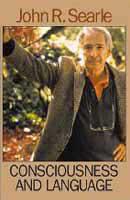
NEWS: Chatbots.org survey on 3000 US and UK consumers shows it is time for chatbot integration in customer service!read more..
Consciousness and Language

Editorial Review
From Publishers Weekly
Lucidly exploring the philosophically hot topics of consciousness, intentionality and language, this set of essays provides a useful overview of Searle’s (Rationality in Action) recent work. All but one of the essays, written over the last two decades, have been previously published, yet they gain by being assembled not only in convenience but in seeing how the problems and proposed solutions connect. The overarching issue, which Searle, a philosophy professor at the University of California, Berkeley, says has “preoccupied” him throughout his professional life, is how to reconcile our commonsense view of ourselves as conscious, mindful beings with a world that supposedly “consists entirely of brute, unconscious, mindless… physical particles in fields of force.” In the first group of essays, Searle rejects both dualist and materialist accounts of consciousness as traditionally construed, arguing instead that “the conscious mind is caused by brain processes and is itself a higher level feature of the brain” with an irreducible “first-person ontology” and the power to cause behavior. He goes on to apply this philosophy of mind to a number of related issues, including animal minds (notably that of his dog, Ludwig Wittgenstein Searle), intentionality (that feature which links mental states to something in the world), collective “we-intentions,” social science explanations and speech acts. Throughout, he spars with rivals, particularly in the final essays, where he attacks Dennett’s functionalism, Quine’s indeterminacy thesis and Kripke’s reading of Wittgenstein. This is not an introductory-level book: many of the issues are abstruse and technical. But Searle’s prose is admirably clear and plain, and he is deft at cutting through jargon to defend a commonsense view of the reality of minds. (May 13) Forecast: Searle is a major philosopher, and university libraries are a lock. Searle’s frequent contributions to the New York Review of Books may draw in some readers, but because most of this work has been previously published, expect few trade reviews.
New Comment
Only registered members are allowed to comment. or login
or login
